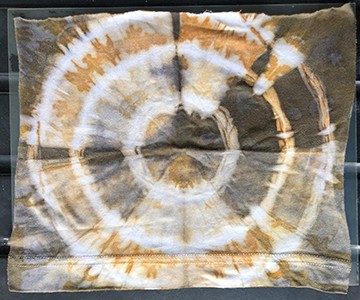FOR IMMEDIATE RELEASE | May 26, 2022
How to tie-dye cotton with acorns and rust
“Tie-Dyeing with Foraged Acorns and Rust: A Workshop Connecting Green Chemistry and Environmental Science”
Journal of Chemical Education
Tie-dyeing is a fun activity that can spice up clothes with colorful patterns. Although kits are available in stores, nature provides dyes that can be extracted from items found in one’s yard — for example, acorns and rust. In ACS’ Journal of Chemical Education, researchers present a “green” process for tie-dyeing cotton with renewable resources and wastes that undergraduate students can easily do under minimal supervision. The activity links together science, art and sustainability.
For thousands of years, materials found in nature have been used as dyes and mordants, which are substances that help affix compounds to fibers. And brown-colored tannins from acorns can bind to orange-colored iron mordant, generating a dark blue, or almost black, color on fabrics. So, Julian Silverman and colleagues wanted to show how these natural dyes can be used in tie-dyeing to produce designs of white, brown, orange and bluish-black colors on cotton napkins. The resulting patterns depended on how the napkins were wrapped in rubber bands and the order in which they were soaked in an acorn dye bath and dipped in a rust and vinegar solution. Even though all of the dyeing solutions are safe to dump down the drain, the researchers say that gloves, lab coats and goggles will keep the dyes from staining skin or other clothing.
The authors acknowledge funding from the Manhattan College School of Science.
To automatically receive press releases from the American Chemical Society, contact newsroom@acs.org.
Note: ACS does not conduct research, but publishes and publicizes peer-reviewed scientific studies.
Media Contact
ACS Newsroom
newsroom@acs.org

View larger image

